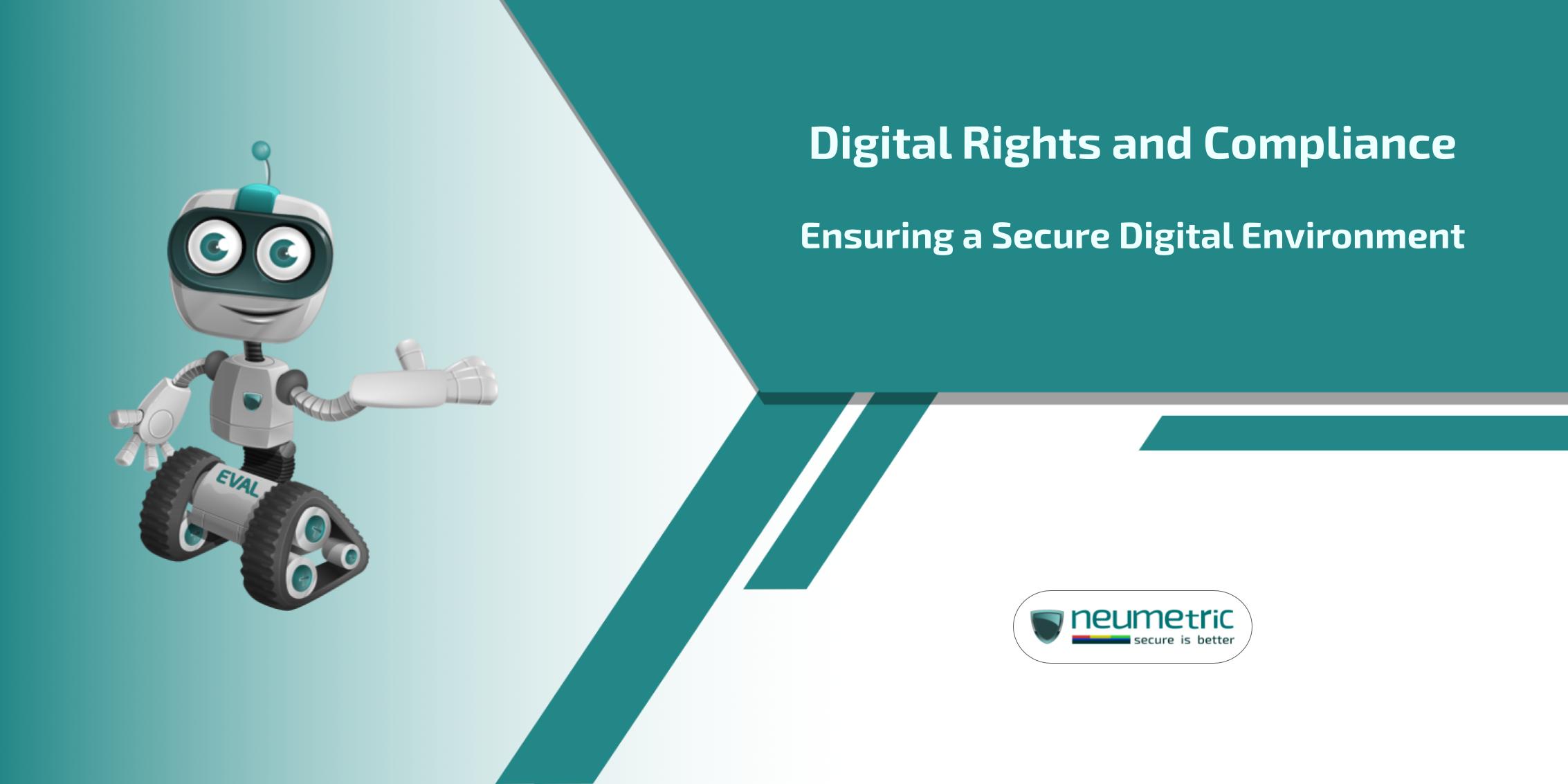Table of Contents
ToggleDigital Rights & Compliance: Ensuring a Secure Digital Environment
Introduction
In an era dominated by technology, the concept of digital rights & compliance has become a critical aspect of our online existence. As we delve into the intricacies of the digital landscape, it becomes evident that safeguarding our digital rights while navigating the ever-evolving world of compliance is paramount.
Our journey begins with a fundamental understanding of digital rights & their significance in the modern age. Digital rights encompass a spectrum of liberties, including privacy, Intellectual Property [IP] & freedom of expression. As we immerse ourselves in an increasingly interconnected world, the need to uphold these rights has never been more crucial. Moreover, the dynamism of the digital environment necessitates a nuanced approach to compliance.
Understanding Digital Rights
To navigate the intricate web of digital rights, we must first comprehend its various facets. Privacy rights, dictating the control individuals have over their personal information, stand at the forefront. Intellectual Property [IP] rights, protecting creators & innovators & the freedom of expression, a cornerstone of democratic societies, round out the trio. These rights, however, are not arbitrary; they are grounded in legal frameworks that vary from national laws to international treaties, forming the backbone of our digital existence.
Furthermore, the significance of understanding digital rights extends beyond a theoretical grasp; it directly influences our day-to-day interactions in the online realm. Privacy rights, for instance, empower individuals to shape their digital footprint, determining who accesses their personal information. Intellectual property rights not only safeguard the fruits of creative labour but also foster a culture of innovation by ensuring that creators are rightfully acknowledged & rewarded.
The freedom of expression, deeply rooted in democratic principles, provides the space for diverse voices to be heard in the digital cacophony. Recognising the real-world implications of these rights helps us appreciate that they are not just abstract concepts but integral guides shaping the ethical contours of our digital citizenship. In essence, a nuanced comprehension of digital rights serves as a compass, steering us toward a responsible & empowered engagement with the digital landscape.
Challenges in the Digital Environment
Yet, this digital utopia is not without its challenges. As emerging technologies such as Artificial Intelligence [AI] & the Internet of Things [IoT] permeate our lives, new digital hurdles emerge. The threat landscape, characterised by data breaches & ransomware attacks, casts a shadow over the seamless flow of information. Balancing innovation with regulatory demands adds another layer of complexity, urging us to find equilibrium in an ever-shifting environment.
In the quest for a seamless digital experience, we encounter the paradox that technological advancements, while promising unprecedented convenience, also bring forth intricate challenges. Artificial intelligence [AI], for instance, heralds a new era of efficiency but raises ethical questions about privacy & bias. The Internet of Things [IoT], interconnecting our devices for enhanced functionality, introduces concerns about data security & cyber vulnerabilities. The looming spectre of data breaches & ransomware attacks further underscores the fragility of our digital utopia.
Striking a delicate balance between fostering innovation & adhering to regulatory frameworks becomes akin to a tightrope walk, demanding a constant reassessment of strategies to navigate this complex interplay between progress & security. In essence, as we embrace the benefits of a digitised world, we must confront & overcome the evolving challenges it brings in its wake.
Navigating Compliance in the Digital Landscape
In the face of these challenges, navigating compliance is key to ensuring a secure digital environment. Frameworks like General Data Protection Regulation [GDPR], California Consumer Privacy Act [CCPA] & Health Insurance Portability and Accountability Act [HIPAA] serve as beacons, guiding businesses & individuals through the maze of regulations. Compliance is not a one-size-fits-all approach; it adapts to industry-specific nuances, providing tailored solutions for the financial, healthcare & e-commerce sectors. Technology, too, emerges as a stalwart ally in this journey, facilitating & automating compliance processes.
In this intricate dance of compliance, the flexibility of regulatory frameworks becomes apparent. GDPR, designed to protect personal data across the European Union [EU], sets a gold standard for privacy rights. CCPA, focusing on Californian consumers, reinforces the idea that compliance is not just a global concern but one that trickles down to regional specifics. HIPAA, governing healthcare data, underlines the need for sector-specific regulations.
This adaptability ensures that businesses aren’t bogged down by generic rules but can instead tailor their compliance strategies to the unique demands of their industry. Moreover, technology doesn’t just sit on the sidelines; it actively participates as a problem-solving ally. From automated data encryption to advanced monitoring tools, technology streamlines the compliance journey, making it a collaborative effort between human ingenuity & digital innovation.
Future Trends in Digital Rights & Compliance
In the fast-evolving landscape of digital rights & compliance, staying ahead of the curve is imperative to ensure a secure & trustworthy digital environment. As we look into the future, several trends are set to reshape the way organisations approach & manage their digital assets. Let’s delve into the upcoming shifts that will undoubtedly impact the realm of digital rights & compliance.
- Blockchain Technology: Blockchain, renowned for its role in cryptocurrencies, is making waves in digital rights management. The decentralised & tamper-resistant nature of blockchain provides a robust foundation for securing digital assets. In the future, we can expect increased integration of blockchain to establish transparent & immutable records of digital transactions, ensuring compliance & authenticity.
- AI-Powered Compliance Solutions: Artificial Intelligence [AI] is set to revolutionise how organisations handle compliance. Advanced AI algorithms can analyse vast datasets, identify patterns & predict potential compliance risks. From automating routine compliance checks to offering real-time insights, AI will play a pivotal role in enhancing the efficiency & effectiveness of digital rights management systems.
- Privacy-Centric Technologies: With growing concerns about data privacy, the future will see an increased emphasis on technologies designed to protect user information. Privacy-centric frameworks & tools will become integral to digital rights & compliance strategies, ensuring that organisations meet evolving regulatory standards while respecting user privacy.
- International Regulatory Collaboration: As digital transactions transcend geographical boundaries, collaboration among international regulatory bodies is becoming crucial. Future trends will witness greater efforts to establish common standards for digital rights & compliance, enabling seamless operations for organisations operating on a global scale.
- Dynamic Compliance Frameworks: Traditional compliance frameworks are often rigid & struggle to keep up with the pace of technological advancements. The future will bring about dynamic compliance frameworks that can adapt to evolving regulations & technological changes. This agility will be essential for organisations to navigate the complex landscape of digital rights & compliance.
- Decentralised Identity Management: Decentralised identity solutions based on blockchain & distributed ledger technology will gain prominence. These systems empower individuals to have greater control over their digital identities, enhancing security & privacy while simplifying compliance processes for organisations.
- Smart Contracts for Compliance Automation: Smart contracts, self-executing agreements with the terms of the contract directly written into code, will streamline compliance processes. Organisations can automate compliance actions through smart contracts, reducing the risk of human error & ensuring that contractual obligations are met in a secure & transparent manner.
Recommendations for Ensuring a Secure Digital Environment
Securing a digital environment is not just a task for IT professionals; it’s a shared responsibility that permeates every level of an organisation. As we navigate the intricacies of safeguarding our digital realm, here are some heartfelt recommendations to fortify the security of our digital ecosystem:
- Cultivate a Culture of Cybersecurity Awareness: Begin with the people. Educate & empower your team about the importance of cybersecurity. Conduct regular training sessions, simulate phishing attacks & foster a culture where everyone is vigilant & understands the role they play in maintaining a secure digital environment.
- Stay Abreast of Emerging Threats: The digital landscape is ever-changing & so are the tactics of cyber threats. Stay informed about the latest cybersecurity threats & vulnerabilities. Regularly update your knowledge base & ensure that your security measures evolve in tandem with emerging risks.
- Implement Multi-Factor Authentication [MFA]: Embrace the extra layer of protection that MFA provides. By requiring multiple forms of identification, such as a password & a unique code sent to a mobile device, you significantly bolster your defence against unauthorised access.
- Regularly Update & Patch Systems: Neglecting software updates & patches is akin to leaving a door ajar for cyber threats. Keep your systems & applications up-to-date to patch vulnerabilities & protect against exploits that could compromise the security of your digital assets.
- Encrypt Sensitive Data: Treat your data like the precious resource it is. Implement robust encryption measures to safeguard sensitive information, both in transit & at rest. Encryption acts as a virtual shield, rendering data unreadable to unauthorised eyes.
- Establish Robust Access Controls: Limit access to critical systems & data to only those who truly need it. Implementing stringent access controls ensures that sensitive information is only accessible to individuals with the appropriate permissions, reducing the risk of unauthorised exposure.
- Conduct Regular Security Audits: Self-reflection is essential in the realm of cybersecurity. Regularly conduct security audits to identify vulnerabilities & weaknesses. Address any shortcomings promptly & view each audit as an opportunity for continuous improvement.
- Backup Data Regularly: Prepare for the unexpected by implementing a robust data backup strategy. Regular backups ensure that, in the event of a cyber incident or data loss, you can swiftly recover & resume operations with minimal disruption.
- Collaborate & Share Threat Intelligence: Cyber threats are a collective challenge. Collaborate with industry peers & share threat intelligence. By pooling resources & insights, we can collectively stay one step ahead of cyber adversaries, fortifying the digital defences of the entire community.
- Adopt a Zero-Trust Security Model: Trust, but verify. Adopt a zero-trust security model that scrutinises every user & device, regardless of their location within the network. This approach minimises the potential damage in the event of a breach & ensures a more resilient security posture.
Conclusion
In conclusion, our journey through the realms of digital rights & compliance unveils the intricate dance between innovation & regulation. A secure digital environment is not an option but a necessity. As we navigate this complex terrain, it is incumbent upon us to be not just digital users but responsible digital citizens, shaping a future where our rights are protected & our digital landscape thrives. The call to action echoes loud – it’s time to forge a path toward a secure & empowered digital future.
FAQs:
Why should I care about digital rights in my everyday online activities?
Digital rights ensure your privacy, protect your creations & uphold your freedom of expression. Just as you’d want your physical space secure, your digital space deserves the same attention. It’s about ensuring your online world aligns with your values & rights.
Can you give an example of how a company successfully implemented digital rights & compliance?
Think of it like this: Companies that prioritise digital rights & compliance are like trust magnets. Take, for instance, those that have seamlessly embraced GDPR regulations. By respecting user privacy, they’ve not just met legal requirements but have also gained customer trust. It’s a win-win – legal boxes ticked & a loyal user base.
With all the buzz about emerging technologies, how can individuals protect their digital rights in the face of new challenges?
Navigating the digital landscape can feel like a tech rollercoaster, but fear not. Stay informed! Understand how AI & the Internet of Things impact your digital space. Equip yourself with cybersecurity knowledge; it’s like having a shield against data breaches. Being proactive & aware empowers you to surf the tech wave securely.





